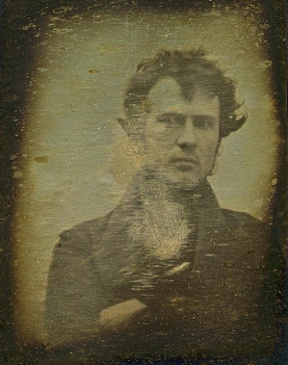
Selfie
- On February 18, 2016
Self Portraiture in the Age of Modern Technology
By Melanie Bindon, Art Gym Denver
We’re all familiar with the selfie pose: camera angled 45 degrees above the eye line, head casually turned to three quarters angle, pouty lips and flexing muscles. Proudly, we show ourselves off to the world one snippet at a time saying “this is me.”
How much of this increasing self-depiction is solely for the gratification of narcissism or could there be more to the rising numbers of selfies?
 Since ancient times, humans have strived for immortalized depictions of themselves:
Since ancient times, humans have strived for immortalized depictions of themselves:
- 39,900 years ago, the oldest hand stencil in the world was made in Leang Timpuseng Cave in Sulawesi
- In 1365 BC, the first identifiable self-depiction was made by Pharaoh Akhenaten’s chief sculptor Bak
- During the 16th and 17th century, the self-portrait was first popularized as an art form
- In 1839, Robert Cornelius created the first photographic self portrait on a daguerreotype
- Starting in the 1960’s, Andy Warhol publicized photographic self portraits with Polaroids
- In the late 1990’s digital cameras replaced film cameras making each photograph replaceable
- In 2010, the iPhone 4 (with a new front-facing camera) made the self portrait go viral
What do you think? Is the meticulous detailing of an artist’s physicality the same as a disposable click of the camera?
In both historical and modern cases, the representation is used to send a specific message about the person creating the image.
Self portraits have historically been used for
- an attempt at immortality
- telling fictionalized narratives
- self promotion (advertising skill level as a portrait painter)
Perhaps the greatest differences between the modern selfie and classical self-portraits is widespread availability, ephemerality and the context of their social interaction.
Selfies are shared to get an instantaneous response and then are forgotten. They are more like speech than documents, they exist as pieces of dialogue incarnate.

Additionally, selfies can empower groups which aren’t readily visible in main stream media to make their bodies visible in a radical way. According to Sarah J Gervais, an assistant professor in psychology,
“[selfies] offer a quiet resistance to the barrage of perfect images we face each day. Rather than being bombarded with those creations… we can look through our Instagram feed and see images of real people- with beautiful diversity.”
Want to explore the topic more?
-
http://museuminabottle.com/2015/01/22/whats-the-difference-between-a-selfie-and-a-self-portrait/
-
http://www.theguardian.com/technology/2014/oct/16/rembrandt-selfie-era-self-portrait
Join us to grow.
Join us to share.
Lend your voice to the conversation.
“You don’t take a photograph, you make it.”
–Ansel Adams
![]()



